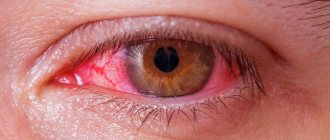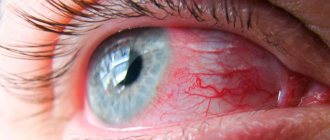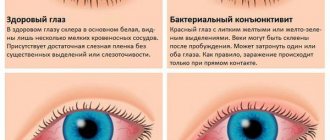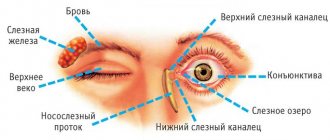What is conjunctivitis?
Conjunctivitis is an inflammation of the conjunctiva, i.e. mucous membrane lining the inner surface of the eyelid and the scleral part of the eyeball.
REFERENCE! According to approximate estimates of experts, about 30% of the population suffers from various forms of eye conjunctivitis. And this is only data on patients under the supervision of ophthalmologists.
The conjunctiva plays an important role:
- provides the necessary level of lacrimation and distribution of tear fluid over the entire surface of the eye. Due to the fact that the visual organs are equally moistened, clear and precise vision is possible.
- Responsible for the sensitivity of the visual organs to light sources.
- Protects the eyeball from drying out.
- Creates a natural barrier and protects the eyes from various microparticles.
Causes of the disease
Conjunctivitis is included in the group of polyetiological diseases. This means that the disease can have different origins:
- In some cases, the disease is associated with contact with the connective membrane of various infectious agents (viruses, bacteria, fungi).
- Another group of causes is non-infectious in nature: physical and chemical irritation of the mucous membrane, allergies.
A favorable factor for the development of the disease can be general weakening of the body. For example, bacterial and viral conjunctivitis often occurs against the background of acute respiratory viral infections, influenza, inflammatory processes inside the sinuses (sinusitis), ear (otitis) and various inflammations in the eye area (blepharitis, dacryocystitis, dry eye syndrome).
The main routes of infection with infectious conjunctivitis:
- contact-household,
- contact,
- airborne.
REFERENCE! This could be sharing personal hygiene items, touching your eyes with dirty hands or using dirty optics, or simply sneezing next to a sick person.
Among microorganisms, the most common causative agents of conjunctivitis are:
- Viruses (herpes simplex and herpes zoster, measles, chickenpox, adenovirus and enterovirus).
- Bacteria. Among them, the palm is held by pathogenic cocci (staphylococci and streptococci, pneumococci, gonococci), enterobacteria (Klebsiella, Escherichia coli), as well as mycobacterium tuberculosis, Pseudomonas aeruginosa and Proteus
Classification
Conventionally, all types of conjunctivitis can be divided into two large groups:
- endogenous,
- exogenous.
The endogenous type of inflammation is a secondary symptom of a particular disease against which it develops. For example: chickenpox, rubella, tuberculosis, hemorrhagic fever, Zika virus, etc.
Conjunctivitis of the exogenous subgroup occurs independently and is associated with the entry of a provoking component into the body. It could be any allergen (dust, fur), bacteria or virus.
According to the characteristics of the course, conjunctivitis is conventionally divided into:
- spicy;
- subacute;
- chronic.
Finally, depending on the etymology, the following types of conjunctivitis are distinguished:
- traumatic,
- allergic,
- fungal,
- chlamydial,
- viral,
- bacterial.
Viral and bacterial types are the most common in both adults and children.
Symptoms
People call conjunctivitis “rabbit eye syndrome” because the disease manifests itself primarily as redness of the conjunctiva and eyeball.
Other symptoms common to different types of disease include:
- lacrimation,
- narrowing of the palpebral fissure,
- blepharospasm (involuntary spasmodic closing of the eyelids).
The remaining symptoms depend on the etymology of the disease and the subjective complaints of the patient. For example:
- feeling of burning and itching in the eye,
- feeling of being clogged
- photophobia.
Viral
Viral conjunctivitis can be caused by a single infection (usually adeno- and enteroviruses) or associated with systemic viral infections - influenza, measles, chickenpox, rubella or mumps.
Treatment of adenoviral conjunctivitis in children
This type of conjunctivitis is transmitted by airborne droplets, affecting the nasopharynx along with the mucous membrane of the eyes. Outbreaks of adenovirus infection in children's groups take on the character of an epidemic.
Symptoms of the disease:
- The combination of adenoviral conjunctivitis with catarrhal symptoms in the nasopharynx is characterized by hyperthermia up to +39°C and enlargement of the pre-auricular lymph nodes.
- The conjunctiva and eyelids become red, swollen, and a small amount of mucus is released from the eyes.
- There is lacrimation and photophobia.
- If the disease takes a follicular form, films or follicles form on the mucous membrane.
- Lesions of the cornea are extremely rare.
Diagnosis of complex damage to the conjunctiva and upper respiratory tract, which is of a viral nature, is carried out on the basis of cytological, virological and serological laboratory tests.
Treatment of viral conjunctivitis is carried out with drops of Albucid (sodium sulfacyl), as a universal medicine for any form of conjunctivitis.
Antiviral eye drops:
- Oftalmoferon
– contain human interferon, which determines its antiviral and anti-inflammatory properties as an immunomodulator. Therapeutic dose is 1-2 drops 6-8 times a day in the acute period, then 2-3 times a day until complete recovery.
- Poludan
– used to treat eye infections caused by the herpes virus and adenovirus. The drops are created as a result of biosynthesis based on cytokines and endogenous interferons. Therapeutic dose is 1-2 drops 6-8 times a day in the acute period of the disease, then 3-4 times for 7-10 days.
- Aktipol
– created on the basis of endogenous interferon, which gives them antiviral and regenerative properties to restore the mucous membrane. It has the qualities of a strong antioxidant. Therapeutic dose – 2 drops up to 8 times a day for 10 days.
As prescribed by a doctor, treatment of viral conjunctivitis is carried out with antiviral ointments. They are used both in pediatrics and for the treatment of adult patients. Before giving ointment to children, a little preparatory work is required. The eyes are washed with antiseptic infusions of tea, sage, chamomile (if these herbs are not allergens for the patient), Albucid or drops with interferon are instilled. After 30 minutes you can apply the ointment. All medications should be used only after consulting a pediatrician or pediatric ophthalmologist.
Antiviral eye ointments:
- Florenal
– used to treat eye infections caused by chickenpox viruses, herpes simplex and herpes zoster, adenovirus. Therapeutic dosage - into the conjunctival sac 2-3 times a day for 10-45 days.
- Tebrofen
ointment
- used to treat all types of viral conjunctivitis, used 3-4 times a day. - Bonafton
– used to treat conjunctivitis caused by adenovirus and herpes simplex virus. Therapeutic dosage for adults is 0.1 g 3-4 times a day for 2-3 weeks, for children – 0.025 g 1-4 times a day for 10-12 days.
On the recommendation of an ophthalmologist, if a bacterial infection occurs, antibiotic ointments (Tetracycline ointment, Erythromycin ointment) can be prescribed.
Diagnostics
When diagnosing conjunctivitis, an ophthalmologist performs the following actions:
- Anamnesis collection.
- External inspection.
- Examination of the cornea using biomicroscopy.
- Laboratory diagnosis of eye discharge to determine the pathogen.
The history includes information:
- about conditions preceding infection: past illnesses, contact with carriers of infection, eye injuries, pharmacotherapy (list of medications used);
- about the nature of the onset and further development of the disease;
- objective symptoms and complaints of the patient: pain, itching, swelling of the eyelids, discharge, etc.
During an external examination, special attention is paid to discharge (purulent or serous), the condition of the parotid and submandibular lymph nodes.
Biomicroscopy helps to assess the intactness of the cornea:
- small pinpoint infiltrates are characteristic of adenoviral conjunctivitis;
- a lesion in the form of a “twig” corresponding to the course of the nerve ending indicates herpetic conjunctivitis;
- a rounded infiltrate with a yellowish center is a sign of a bacterial process.
To determine the type of pathogenic microflora, laboratory diagnostics are prescribed:
- bacteriological examination of the contents of the conjunctival sac;
- cytological examination of scrapings from the conjunctiva for the presence of viruses.
ATTENTION! In some cases, consultation with other specialists (urologist, gynecologist, allergist) may also be required.
Diagnosis consists not only in determining the type of conjunctivitis, but also in differentiating it from other diseases of the organs of vision:
- keratitis (inflammation of the cornea),
- episcleritis (inflammation of the connective tissue between the sclera and conjunctiva),
- uveitis (inflammation of the uvea of the eye),
- scleritis (autoimmune inflammation of the deep layers of the sclera of the eye),
- the presence of a foreign body in the eye,
- an attack of glaucoma,
- canal obstruction (occurs with dacryocystitis).
Differences in therapy for different etiologies
The prescription of medications depends on the nature of the pathogen:
- bacterial conjunctivitis is treated with broad-spectrum antibiotics in the form of eye drops or ointments;
- Treatment of viral conjunctivitis includes local use of antiviral drugs, specific antiviral immunotherapy and the use of general restoratives.
In addition, in case of a bacterial infection, eyelid toilet is prescribed - washing the conjunctival cavity with weak solutions of disinfectants. This helps remove purulent discharge and crusts that have formed.
REFERENCE! Bacterial conjunctivitis is more sensitive to therapy than viral conjunctivitis. Typically, treatment does not shorten the duration of viral conjunctivitis. It follows its clinical course (2 to 4 weeks), and medications only help to reduce symptoms and reduce the likelihood of the disease spreading.
Drops
Drops are an effective and easy-to-use dosage form. In addition, the liquid substance envelops the membrane of the eyeball without reducing visual acuity, such as ointments. Therefore, drops are preferable during the daytime.
For bacterial infections
An important role in the treatment of bacterial conjunctivitis is played by rinsing with antiseptic solutions:
- "Okomistin"
- Boric acid eye drops.
After mechanical cleansing of the eyelids and connective membrane from purulent discharge, local antibacterial drugs are used:
- "Albucid" (sodium sulfacyl),
- "Levomycetin" (chloramphenicol),
- "Floxal" (ofloxacin),
- "Neomycin"
- "Ciprofloxacin."
Even if the disease affects only one eye, it is necessary to extend therapy to the second. The frequency of instillations is determined by the severity of the disease (4-6 times a day). In severe cases, drops are prescribed every hour.
For viral infections
Eye drops used in the treatment of viral conjunctivitis can be divided into the following categories:
- the main drugs are antiviral agents (“Florenal”, “Aktipol”, “Oftalmoferon”);
- immunostimulants (for example, “Poludan” - lyophilisate for the preparation of nasal drops);
- in severe cases, especially when conjunctival edema appears, corticosteroid eye drops based on dexamethasone (Dexapos, Maxidex) are prescribed;
- tear replacement therapy using “artificial tears” preparations (“Vizin”, “Hilo-Komod”, “Slezin”, etc.).
Expert opinion
Danilova Elena Fedorovna
Ophthalmologist of the highest qualification category, Doctor of Medical Sciences. Has extensive experience in diagnosing and treating eye diseases in adults and children.
The most in demand are combination drugs that have antiviral and immunostimulating effects (“Aktipol”). Eye drops "Ophthalmoferon" (based on interferon), among other things, have: anti-inflammatory, local anesthetic, antihistamine effect and antiseptic effect against secondary bacterial infection. The metacel included in the composition eliminates dryness (an “artificial tear” preparation).
Ointments
Ointment-based medications have a local effect. Their advantage over drops is their more viscous consistency, which prevents them from being washed away by tears. Thus, the contact of the drug with the surface of the eye is longer and more effective.
However, ointment placed in the conjunctival sac can create discomfort, so it is recommended for use at night.
For bacterial infections
Popular drugs:
- “Tetracycline ointment” (1% or 3%) is a broad-spectrum bacteriostatic antibiotic;
- Ofloxacin is an antimicrobial agent.
Among the combined antibacterial ointments are:
- "Alfatex" (Eubetal Antibiotic) - tetracycline, betamethasone, chloramphenicol, sodium colistimethate,
- "Colbiocin" - tetracycline, chloramphenicol and colistin.
With a viral form
Viral forms of conjunctivitis require the use of viruscidal and virusostatic agents based on:
- acyclovir (Zovirax, Virolex),
- oxolina,
- tebrofen,
- bonaftone (bromonaphthoquinone).
To prevent the addition of a bacterial infection, treatment can be supplemented with antimicrobial drugs.
Similar to the treatment of severe forms of the disease with eye drops, it is possible to use glucorticosteroid ointments (Hydrocortisone, Dex-Gentamicin).
Folk remedies
For inflammation of the mucous membrane of the eyes, adherents of herbal medicine advise using decoctions:
- chamomile flowers,
- calendula,
- cornflower,
- dill greens,
- bay leaf,
- fennel seeds,
- rosehip.
These plants have excellent antiseptic properties and relieve swelling. Decoctions are used for external washing of the eyes or as compresses to facilitate the outflow of pus. To do this, soak a clean cotton pad with liquid and apply it to the affected eyelid for 5-20 minutes.
Compresses can also be prepared from:
- ground aloe leaves,
- grated potatoes and egg white.
REFERENCE! The most popular remedy for conjunctivitis, firmly entrenched in the minds of compatriots, is fresh tea leaves. Both black and green tea are used. Rub the eyes with warm liquid so that the pus that has dried after sleep can be easily separated.
Difference between viral and bacterial conjunctivitis
To make a diagnosis, a doctor must distinguish between viral and bacterial conjunctivitis. For each form of the disease, there are remedies and treatment methods. If antibacterial agents are prescribed for viral conjunctivitis, the patient's condition will worsen. On the contrary, in the presence of bacterial microflora, the use of antiviral drugs does not improve a person’s well-being; the infection will multiply.
Photo
Bacterial conjunctivitis
Viral conjunctivitis
By symptoms
Viral conjunctivitis is characterized by the following clinical symptoms:
- absence of purulent exudate from the corners of the eyes, so a person can open his eyes in the morning;
- severe inflammation and swelling of the eyes;
- increased sensitivity to bright colors, which manifests itself as tearing;
- in the absence of treatment, increased tearing is replaced by dry mucous membrane, which leads to microtraumas on the cornea;
- if the disease is complicated by the addition of a bacterial infection, little pus is released in the nasal passages;
- severe redness of the mucous membrane of the pharynx, sore throat.
With a viral infection, body temperature often rises. These can be low-grade values ranging from 37-37.5 degrees or high values - more than 38 degrees. It depends on the type of pathogen and its prevalence in the body.
With bacterial conjunctivitis, the following clinical symptoms occur:
- copious green and yellow discharge from the inner corner of the eyes, due to which a person cannot open his eyes in the morning;
- discharge from the eyes is viscous and dries out if not eliminated in time;
- the degree of inflammation and swelling depends on the form of bacterial conjunctivitis (catarrhal or acute);
- Sensitivity to the action of bright light and the release of tear fluid is not always formed;
- If left untreated, suppuration can spread to the nasal passages, where pathogenic microflora multiply, causing purulent rhinitis.
Based on clinical symptoms, the doctor will determine viral or bacterial conjunctivitis. But only laboratory testing can confirm the diagnosis.
Prevention
Preventive measures are designed not only to prevent its relapses.
The basic rules for avoiding conjunctivitis infection come down to maintaining personal hygiene:
- regular hand washing;
- use of individual towels, scarves, bed linen, skincare and decorative cosmetics (mascara, eye cream, etc.);
- lack of close physical contact with carriers of infection;
- minimal physical contact with objects in common areas.
If infection does occur, the following measures will help speed up recovery and prevent complications:
- do not rub your eyes, because conjunctivitis spreads easily from one eye to the other;
- remove crusts and discharge in the direction from the outer corner of the eye to the inner;
- Using a separate disk to wash each eye.
In order to protect others, the patient is advised to avoid places with large crowds of people (kindergartens, schools, public transport, swimming pools, etc.) and public events.
Useful video
All about conjunctivitis in the program Live Healthy!











